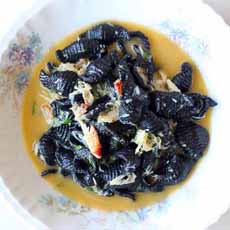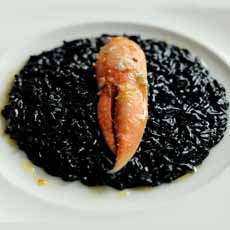TIP OF THE DAY: Squid Ink Pasta (Really Cuttlefish Ink)
|
[4] Squid Ink Risotto. Here’s the recipe from Chef Andrew MacKenzie | Great British Chefs. |
As a coloring agent in pasta, squid ink—actually cuttlefish ink—has no detectable flavor. But the color is dramatic, especially against a red or white sauce.
Whether you’re cooking for a family or a gourmet crowd, squid ink pasta is especially noteworthy during Halloween season. The pasta needs no special garnish—squash or carrots sliced into pumpkin shapes, radish or hard-boiled egg “eyeballs”e.g.—to have a holiday impact (but…feel free). Squid ink pasta and risotto are elegant at any time of the year. One of our go-to party dishes: squid ink angel hair pasta topped with pan-fried scallops and pink vodka sauce. It’s simple to make, with high optics. Squid is an English language misnomer for what is actually cuttlefish, or seppia in Italian. Cuttlefish are cephalopods like squid, but are much a smaller and have a bony internal shell. They taste like squid, but are distant cousins. Cuttlefish thrive in warmer waters, such as the Mediterranean. They’ve long been a staple food along the coastlines of Greece, Italy and Spain. Since earlier generations could afford to waste nothing, uses for every part of everything were pursued. Cephalopods, including squid and cuttlefish, have an ink sac. The ink is a dark pigment, released into water as an escape mechanism. We don’t know how many thousands of years ago the ink was first used in food, but we do know that in Greco-Roman times the cuttlefish was a source for ink. It is mentioned by Aristotle. The cuttlefish provided: Cuttlefish ink is actually better for food color: It’s more viscous than squid ink; and far better on the palate, according to those who have made sauces with both. Italian cookbook author notes the difference between the two: “To the Italian palate, the harsh, pungent ink is the least desirable part of the squid. As Venetian cooks have shown, it’s only the mellow, velvety, warm-tasting ink of cuttlefish—seppie—that is suitable for pasta sauce, risotto, and other black dishes.” (Marcella Hazan, Essentials of Classic Italian Cooking, 1992) The ink is also used in a popular sauce for seafood dishes and pasta. It contains chunks of seppia, olive oil, sautéed garlic and/or onions, tomato paste, white wine, parsley and pepper. Here’s a recipe. (Culinary note: In Italy, grated cheese is never served with seafood pasta dishes.) If you make your own pasta, you can buy the ink. We’ve been able to buy squid ink pasta dough at a local ravioli shop, and have also bought their squid ink ravioli filled with pumpkin. It’s a great Halloween surprise: cut into the black pillow and get an explosion of orange! For maximum color impact, place them the cooked pasta on top of the sauce. |
|






